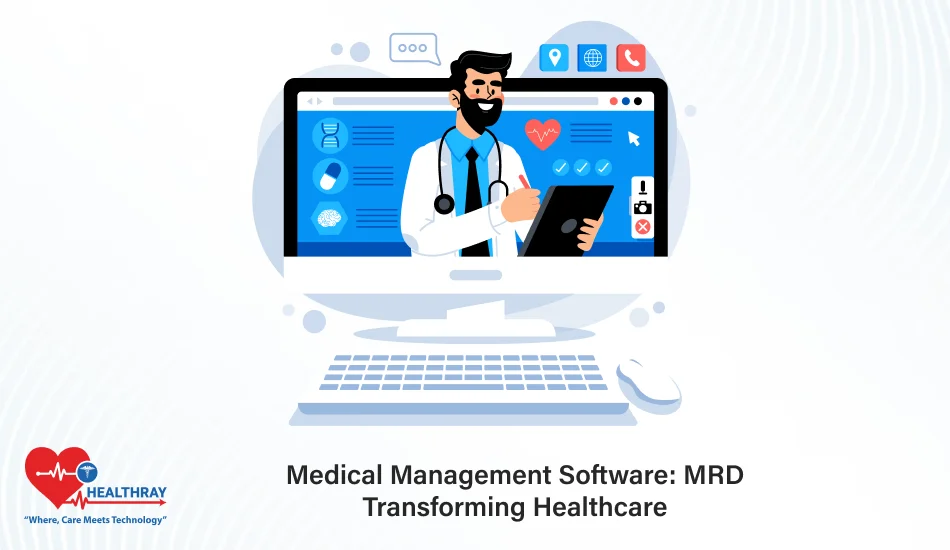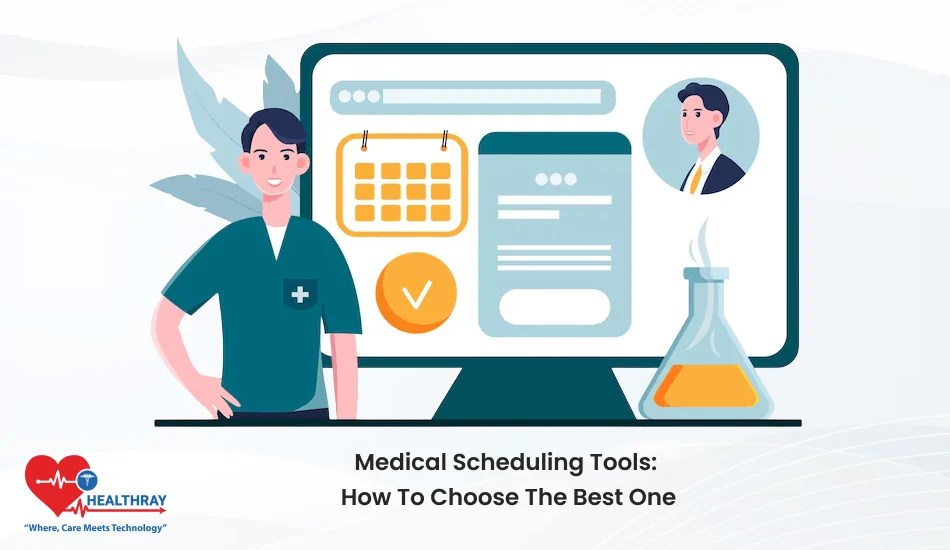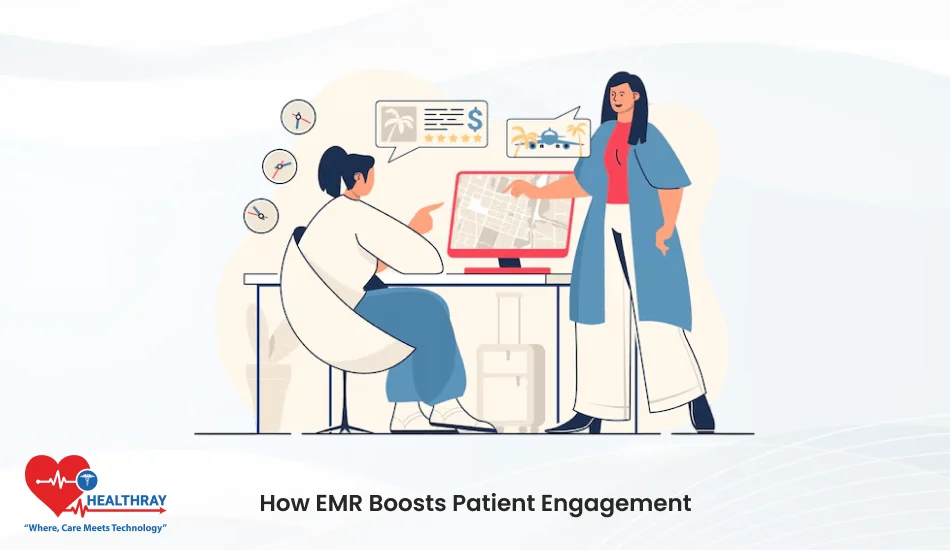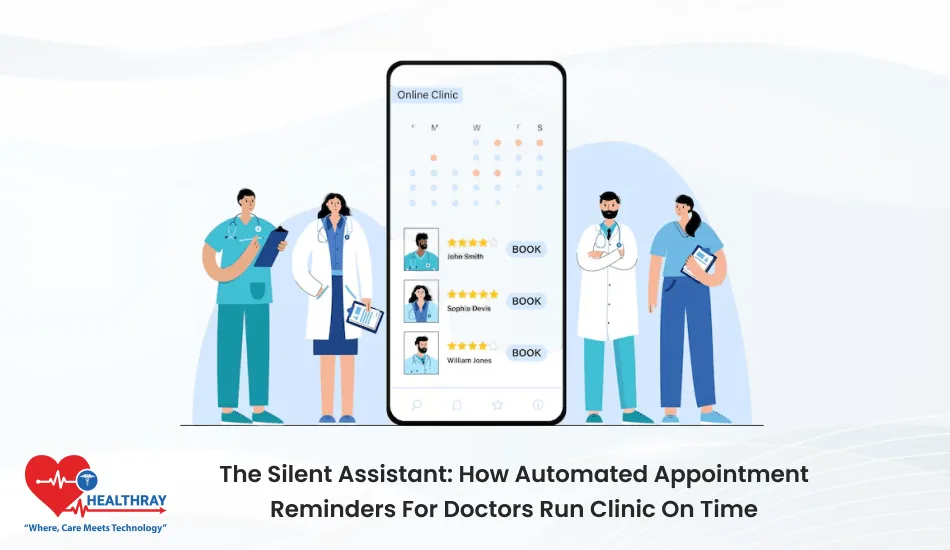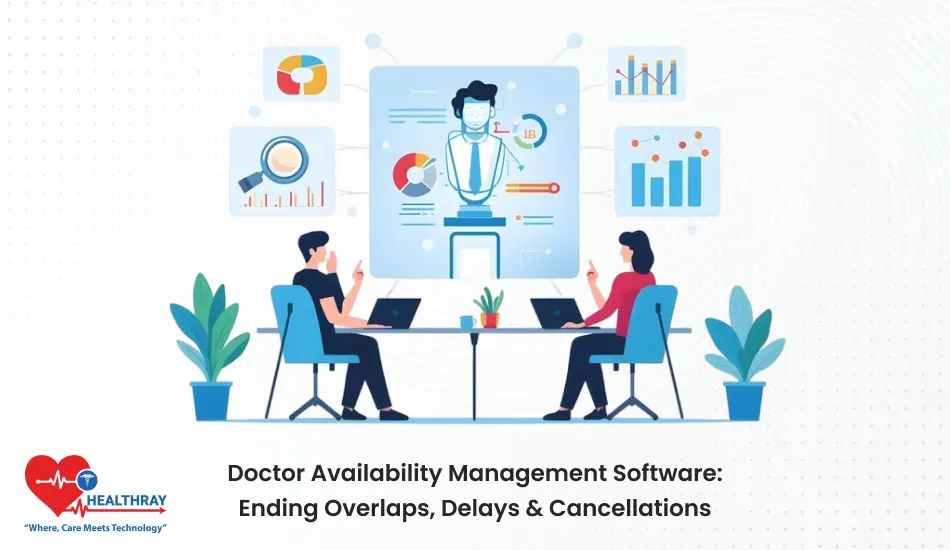MRD thus plays a very crucial role in the effective flow of health care. They ensure that the records of patients are accurate, maintained according to all legal standards, and provide data-based decisions with the aim of improving the delivery of care. Paper-based or even outdated record-keeping systems introduce inefficiencies, inaccuracies, and even risks regarding data security.
This is where the integration of medical record departments with hospital management software comes into play. Digitization and automation in handling patient records will help healthcare providers in streamlining operations, data security, and quality of treatment.
In this publication, we will look at how MRD management software is transforming healthcare. We will further elaborate on its key features, the benefits it brings to hospitals and healthcare systems, and how it shapes the future of patient care.
Key Features of Effective MRD Management Software

The different nature of each healthcare operational challenge requires that effective MRD management software be designed for the streamlined handling of patient records, keeping in mind regulatory compliance and coordination with other departments. So, let’s have a closer look at some indispensable features of such systems.
Overall management of patient records.
Central to any MRD in medical software is the functionality of systematically storing and managing enormous patient data-from medical history to treatment plans. It provides easy access to well-maintained data. With the capability for centralized repositories and advanced search functionality, healthcare professionals are now able to locate records in just seconds, saving precious time.
Data Security and Compliance
Medical management deals with sensitive information about patients and is bound by strict laws like HIPAA or GDPR. Strong MRD systems have:
Data encryption for protection.
Role-based access controls to restrict who sees and edits records.
Audit trails track all modifications and access events.
This helps these organizations to retain confidence and not face any legal or financial sanctions.
Integration with Other Systems
Contemporary health facilities therefore use EHR, billing platforms, and diagnosis software in daily practice. When such applications are fully integrated, MRD will be able to function within harmonized ecosystems for smooth workflows with reduced redundant data entry.
Automation and Workflow Optimization
Manual processes result in several inefficiencies and slow down the entire process of record management. Therefore, MRD software automates the following tasks:
Record categorization and indexing.
Appointment reminders for follow-ups.
Compliance checks against data completeness.
This automation enhances not only productivity but also reduces human error.
Advanced Analytics and Reporting
Information in MRDs acts like a goldmine of insights. Analytics tools in the software help in:
Identify trends in patient care and outcomes.
Ensure the optimization of resources at the facility.
Monitor compliance with requirements set by regulatory bodies.
Customizable reporting enables administrators to provide valuable insights into decision-making.
Scalability & Cloud Accessibility
Scalable MRD software allows for growth in size within healthcare organizations with no compromise on performance. Moreover, cloud-based solutions ensure that all patient files remain secure at any one time from any location.
Benefits of MRD Management Software
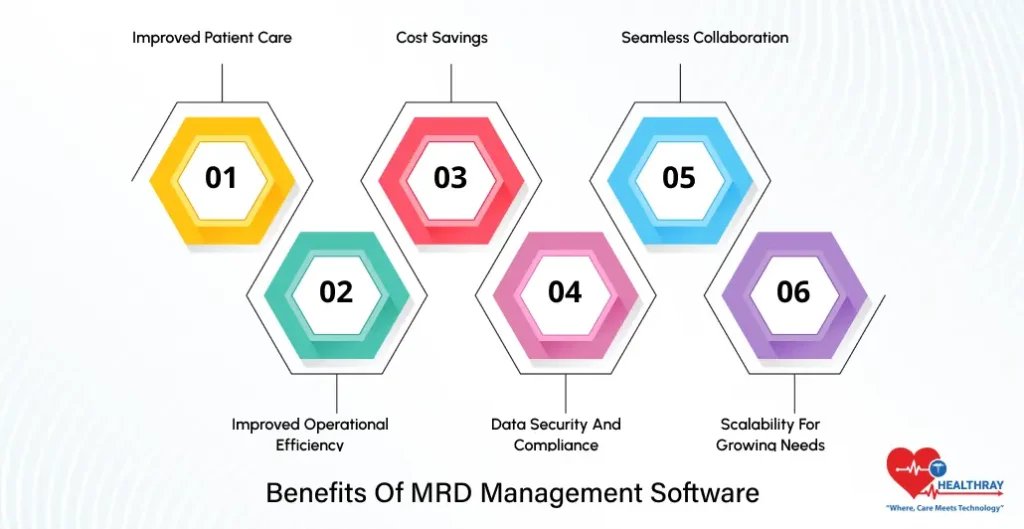
The implementation of medical record department management software has several advantages on the part of healthcare organizations to streamline their processes, improve patient care, and make compliance with evolving healthcare regulations easier. Major benefits can be broken down as under:
Improved Patient Care
Proper care will include quality access to updated and accurate patient medical records. Medical Record Department software ensures that the patient’s history, diagnostic results, and treatment plans are obtained promptly from health practitioners, resulting in informed decisions with minimal probability of medical errors.
Example: In the event of the patient attending to another specialist, the system would furnish a full medical history in just mere seconds, thus allowing personalized care without delays.
Improved Operational Efficiency
Managing such records manually is very time-consuming and prone to errors. Automation of processes such as record indexing, scheduling, and compliance checks by the MRD software frees the administrative staff to attend to more important tasks. This further cuts down on the time used in searching for records or rectifying such errors.
The result is faster workflows, less patient wait time, and easier day-to-day operations.
Cost Savings
Automation decreases the reliance on paper-based systems, storage space, and manpower involvement. The savings attributed to such may include:
Reduced costs of physical storage.
Reduced administrative overhead.
Fewer penalties related to compliance, because of better management of data.
These cost savings can be reinvested into patient care and facility upgrades for hospitals operating on tight budgets.
Data Security and Compliance
Security of patient data has become highly essential in the present context with the adaptation of strict regulations such as HIPAA and GDPR. Security is inbuilt into MRD management software through encryption, access controls, and audit trails, thus securing sensitive information. It helps organizations to remain compliant with ever-changing legal requirements.
Impact: This reduces the likelihood of data breach incidents and potential lawsuits and fines affecting the institution.
Seamless collaboration
Integrated MRD systems allow for communication amongst departments. The doctors, nurses, and administrative personnel can access the same records at the same time without having to transfer any of these manually, hence eliminating delays.
Lab results, imaging studies, and treatment history are available directly during the time of surgery so that every decision made is well-informed.
Scalability for Growing Needs
Healthcare facilities expand, either through physical growth or increases in patient volumes. With scalable MRD software, the system remains able to handle such growth without the loss of speed or reliability. Additionally, cloud-based options offer flexibility for remote access and are ideal for telemedicine applications or multi-location facilities.
Issues in Implementing MRD Management Systems

Though very useful, MRD management systems have their own set of problems during implementation. Recognition of these problems will help an organization to plan better and overcome those problems effectively.
Data Migration from Paper to Digital Records
Many health facilities still use paper-based systems for maintaining records. Switching over to a digital MRD system includes:
Scanning and digitizing the thousands of already existing records.
Ensuring accuracy in data entry.
Establishing appropriate categorization for easy retrieval.
This can be very resource-intensive at times, even requiring an entire team that is only responsible for overseeing the migration.
Solution: Focus on the critical records for migration and utilize the bulk-scanning technologies for rapid processing.
Training Staff & Managing Change
This does tend to create resistance among employees who have worked with traditional systems. There is a definite learning curve when it comes to MRD software, which can momentarily disrupt workflow.
Key Issues:
Lack of familiarity with the software.
Fear that technology could replace human jobs.
Resistance to the changeover of new processes.
Solution: The regular training sessions, continuous support, and process of involving staff in implementation all contribute to gaining staff buy-in.
High Initial Costs
Setting up an MRD management system requires substantial upfront investment in software, hardware, and training. Smaller facilities or those on a tight budget might find it hard to justify the initial cost.
Solution: Select software solutions that are scalable and can be implemented in phases. Emphasize the long-term savings like reduced administrative costs and lower storage costs to justify your investment.
Ensuring Interoperability
Many digital systems are used within health facilities for billing, diagnostic imaging, and electronic health records, among others. In fact, the integration of the MRD system with such existing platforms is very complicated.
Key Challenges:
Inconsistent data formats.
Incompatibility with the existing/legacy systems.
Need for custom APIs or middleware.
Solution: Partner with those vendors that can provide integration support; where possible, prefer systems that have open APIs.
Data Security Risks
Digitization of patient records carries a potential threat of cyber attacks. The exposure could be through hacking, ransomware, data breaches leading to unauthorized access of sensitive information relating to patients, and possible legal and reputational consequences.
Solution: It comes with strong security features of encryption and access controls. Periodically conduct improvements in the software. Conduct audits and detect all the loopholes to remove them.
Adapting to Changes in Regulations
Health care regulations are in continuous dynamics, and MRD systems need to be up-to-date. Often this is achieved with periodic software upgrades and adjustment of workflow processes.
Solution: Choose software vendors that update changed regulations at regular intervals. Retain compliance personnel in-house who can concentrate on monitoring new requirements.
Case Studies: Successful MRD Management Software Implementation
Real-world examples show the transformational power of MRD management software. These cases highlight exactly how organizations have been able to leverage these systems to drive up efficiency, better patient care, and compliance.
Improving Patient Care within a Regional Hospital
BACKGROUND: This mid-sized regional hospital sometimes experienced delays and errors in treatment because of delays in access to patient records. The institution used a mix of paper and legacy digital systems as approaches to record keeping; these caused inefficiency in the retrieval process.
Solution: Selection of the all-in-one end-to-end MRD management software for the hospital was made in light of its integration with its EHR system. Real-time availability of the data, its automated indexing, and advanced search functionalities proved to be very important features.
Results:
Time taken to retrieve records: 70% reduction, hence physicians can arrive at decisions sooner.
Error rate: This has reduced considerably owing to the automated checks on the accuracy of the data.
Patient Satisfaction: Improvement of 25%, along with quicker cycles of treatment with less waiting time.
Smoothening Processes within a Multi-location Healthcare Network
Background: A healthcare network operating clinics in several locations felt a need to share patient records. Though email and physical document transfers have thus far been a means for such sharing, resultant duplication and miscommunication among staff are common problems.
Solution:It provided a cloud-based MRD system that allowed secure access to patient records from all locations. The system also integrated with the network’s telehealth platform.
Results:
Operational Efficiency: Enhanced by 40%, with transparent sharing of records between the clinics.
Cost Savings: Realized $50,000 annually with the elimination of courier and duplication costs.
Staff Collaboration: Allows access to shared records in a centralized and secure manner.
Achieving Compliance in a Large Urban Hospital
Background: One big city hospital was under the constant audits of the regulatory administration- being fined because of the poor MRD practices, when processes regarding data storage and retrieval did not meet the updated legal standards.
Solution: The MRD management system installed in the hospital provides compliance tracking with audit trails. The system is further secured by adding role-based access controls and encryption.
Results:
Compliance Rate: Increased to 100%; no fines resulting from any follow-up audits.
Data Breach incidents reduced by 90%, ensuring better patient trust and hospital reputation.
Reduction in audit preparation time by 60% due to automated reporting tools.
Future Trends in MRD Management Software
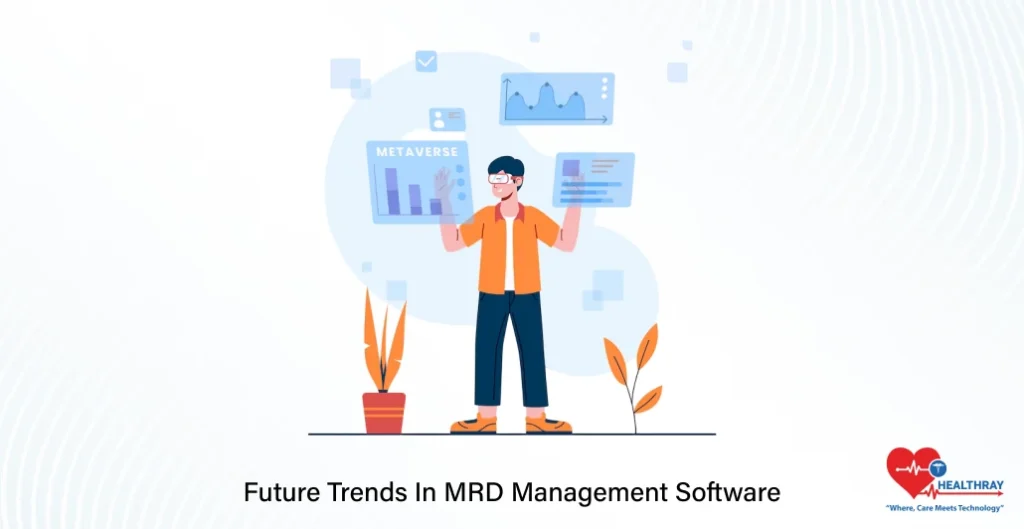
The MRD management software landscape is rapidly changing. Emerging technologies and innovative ways are revolutionizing the handling of patient information in healthcare facilities. Here are some of the trends to watch as the future of MRD management takes shape.
Integration of Artificial Intelligence (AI)
AI is transforming MRD systems by automating repetitive tasks and providing insight at scale. Other key developments include:
Natural Language Processing: Data extraction from unstructured records, such as doctor’s notes or scanned documents.
Predictive Analytics: To identify the patient trends and their health risks, including their history developments.
Automated Indexing: Categorizing records with speed and accuracy in order to reduce manual data entry.
Impact: AI-driven MRD systems save time, reduce errors, and enhance decision-making on the part of healthcare professionals.
Cloud-based Solutions
Cloud computing is growing as a backbone for the modern MRD system owing to advantages such as:
Scalability: The ability to deal easily with growing data volumes, without needing any infrastructure upgrades.
Remote accessibility :means that the authorized staff can access the records from any place in a secure way.
Cost Efficiency: No on-premise storage and maintenance required.
Future Outlook: As telemedicine and multi-location health networks grow, cloud-based MRD will be indispensable.
Focus on Interoperability
Therefore, there is an increasing trend in healthcare providers toward making the MRD system integrated with other platforms such as EHR, billing systems, and diagnostic tools. This has been furthered by standards such as HL7 FHIR.
Advantages: Future systems will focus on data interoperability between platforms for extended collaboration and continuity of care.
Advanced Data Security Measures
With growing threats in cyber space, the efforts for securing patient data also increase. Some of the emerging security measures include:
Blockchain Technology: Immutable records of data that guarantee transparent audit trails.
Advanced Encryption: Keeping sensitive information out of the reach of unauthorized parties.
Zero Trust Architectures: Seamless verification of access requests to avoid security breaches.
Outcome: Improved data security inspires confidence, ensuring adherence to ever-increasing regulations.
Patient-centered innovations
Patients are increasingly active partners in their care journey. Future MRD systems will enable:
Patient portals allow patients to access their record, schedule appointments, and communicate with healthcare providers.
Mobile Applications: That means access anywhere and healthy engagement for the patients.
Personalized experiences: data analytics applied in patient care plans.
Impact: These are innovations that will empower patients, build better relationships among providers in their communities.
Integration of IoT and wearables
The further evolution of MRD is foreseen to be the incorporation of big volumes of health information emanating from wearables and the IoT.
Examples:
Vital sign monitoring from wearable devices.
Data synchronization from smart diagnostic tools.
Potentials:These will enable early interventions and, therefore, more personalized care.
Conclusion
Medical records management software plays a key role in reshaping the healthcare environment to deliver speedier, safer, and more efficient patient care. Equipped with powerful features, addressing challenges, and leveraging emerging trends in AI, cloud computing, and enhanced data security, healthcare providers can reinvent their ways of managing patient records. The shift towards digital Hospital Administration Software is not merely a technological upgrade; it’s a strategic thrust toward operational efficiency and personalized patient care. Only those hospitals, clinics, and multi-location healthcare networks will emerge as better facilitators of modern healthcare needs. The investment in the right MRD system is not one of compliance or saving money but is about building a future for tomorrow-a future wherein healthcare shall be driven by correct data, smooth collaboration, and commitment to improvement in patient outcomes.
